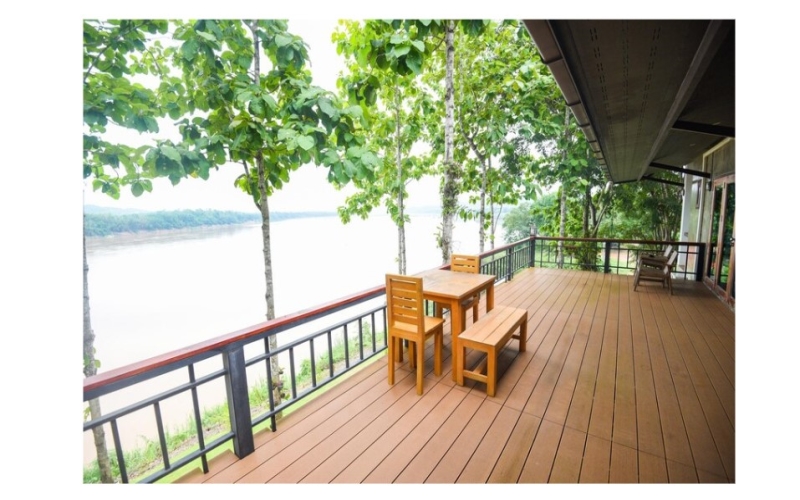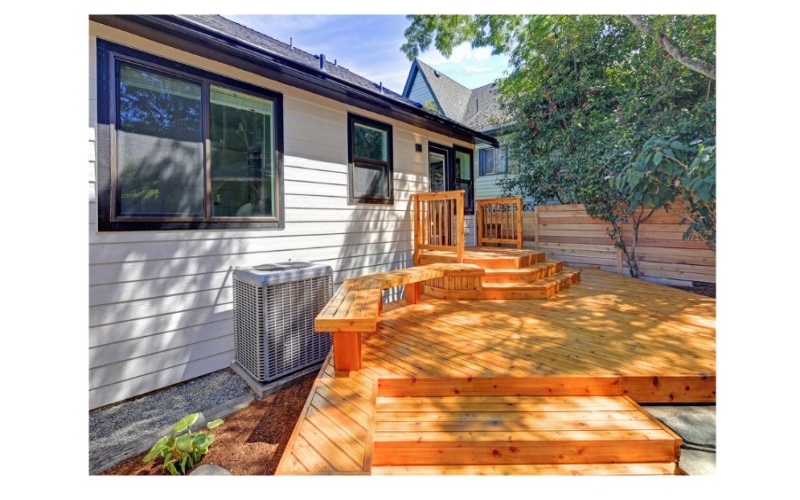Outdoor decking is a popular home improvement option that enhances outdoor living spaces. Usually made from wood or composite materials, decks create a stylish and functional area for dining, entertaining, or relaxing while increasing home value.
Importance of high-quality composite wood decking on exterior spaces
High-quality composite wood decking transforms exterior spaces, enhancing aesthetics and usability. It provides a durable, low-maintenance option that can withstand harsh weather conditions. This sustainable solution offers longevity and beauty, maximising property value and enjoyment.
What is High-Quality outdoor composite wood decking?
Definition and basics of composite wood decking
Composite wood decking is a popular outdoor flooring option that combines natural wood with synthetic materials like plastic and resin. Outdoor composite wood decking is durable, weather-resistant, low-maintenance, and mimics the aesthetics of real wood while preventing decay and termite damage.
Materials used in composite wood decking
Composite wood decking materials are primarily composed of a mixture of plastic and wood fibres. The plastic component can be either recycled or virgin, while the wood is typically recovered from byproducts of the milling process or recycled wood waste.
Advantages of high-quality composite wood decking
High-quality composite wood decking is durable, low-maintenance, and eco-friendly. It is resistant to rot, insect damage, and harsh weather conditions. Additionally, its exceptional aesthetic appeal enhances the value of outdoor living spaces, providing lasting beauty.
Enhancing Exterior Space with Composite Wood Decking
Enhancing exterior spaces with composite wood decking adds a stylish, low-maintenance option for outdoor living. The material is durable, resistant to weathering, and comes in various colours and textures mimicking natural wood, transforming gardens into cosy, inviting retreats.
Aesthetic appeal of composite wood decking
Composite wood decking offers an aesthetic appeal that seamlessly blends with nature’s beauty. Its varied colour options and texture mimic natural wood grain, making it a sustainable choice that doesn’t compromise on style and visual harmony.
Customization options for composite wood decking
Composite wood decking allows for extensive customisation options. You can choose from a range of colours, textures, and finishes to match your aesthetic preferences. It can be cut and shaped to fit any deck design, providing flexibility and uniqueness to your outdoor living space.
Effect of composite wood decking on property value
Composite wood decking significantly enhances property value due to its durability, aesthetic appeal, and low maintenance needs. This reliable home addition improves outdoor living space, which potential homebuyers often highly value, thereby boosting the market price.
Durability and Longevity of High-Quality Outdoor Composite Wood Decking
High-quality outdoor composite wood decking is renowned for its durability and longevity. Resistant to fading, staining, scratching, and mould, it maintains its appearance for years. Its superior longevity makes it a cost-effective, sustainable choice for outdoor living spaces.
The life expectancy of composite wood decking
The life expectancy of composite wood decking is impressive, generally lasting between 25 and 30 years with proper maintenance. This durability surpasses that of traditional wood, which typically lasts 10 to 15 years. Its resistance to weather and pests contributes to its longevity.
Maintenance and care practices for prolonged use
Proper maintenance and care practices significantly prolong the lifespan of equipment. These include regular inspections, cleaning, and timely repairs. Adhering to prescribed guidelines ensures optimal performance, reduces costs, and prevents untimely breakdowns and replacements.
Impact of weather and external factors on composite wood decking
The performance and longevity of composite wood decking are greatly influenced by weather and external factors. Ultraviolet rays, rainfall, humidity, and temperature fluctuations can cause discoloration, warping, and decay, reducing the deck’s aesthetic appeal and structural integrity.
Environmental Impact of Using Composite Wood Decking
The eco-friendliness of composite wood decking
Composite wood decking is an eco-friendly alternative to traditional hardwood. It’s made from recycled materials, reducing waste and deforestation. Additionally, it requires less maintenance and harmful chemical treatments than natural wood, significantly reducing its environmental impact.
Sustainability efforts in composite wood decking production
Composite wood decking producers are increasingly adopting sustainable practices, such as using recycled wood and plastic materials in production. They also strive for energy-efficient manufacturing processes, reducing waste and environmental impact.
Role of composite wood decking in waste reduction
Composite wood decking plays a crucial role in waste reduction as it’s primarily made from recycled materials like plastic and wood waste. This not only reduces landfill burden but also enhances forest preservation by using less virgin wood.

Cost-effectiveness of High-Quality Outdoor Composite Wood Decking
The initial cost of composite wood decking
The initial cost of composite wood decking can be higher than that of traditional wood. This is due to the materials’ durability and low maintenance requirements. However, the investment often pays off in reduced upkeep efforts and expenses over time.
Long-term financial benefits of high-quality composite wood decking
High-quality composite wood decking presents significant long-term financial benefits. It’s durable, requiring less maintenance and repair costs than traditional wood. It’s resistant to weather and pests, thereby increasing its lifespan and reducing replacement costs.
Comparing costs between composite wood and traditional wood decking
Traditional wood decking is often less expensive initially but includes high maintenance costs over time. Composite wood decking, though more costly upfront, requires less maintenance, making it cost-effective in the long run.
Installation and maintenance of composite wood decking
Key steps in the installation process
The key steps in the installation process include identifying the appropriate software or hardware, securing necessary permissions, performing initial setup, testing the installation for functionality, troubleshooting any issues, and finally, confirming successful installation.
Required tools and equipment for installation
Proper installation of any equipment necessitates the use of specific tools. These may include screwdrivers, wrenches, pliers, drills, hammers, and wire cutters. Moreover, safety gear like gloves, safety glasses, and helmets are essential.
Routine maintenance practices and their benefits
Routine maintenance practices, like regular equipment inspection and servicing, are beneficial in several ways. These practices enhance performance, prolong equipment lifespan, reduce unexpected breakdowns, and save money otherwise spent on substantial repair costs, thereby boosting overall productivity.
Outdoor composite wood decking FAQs
What is the disadvantage of composite decking?
The main disadvantage of composite decking is its cost, as it’s often more expensive upfront than traditional wood. It can also fade over time, scratch easily, require extra care, and be slippery when wet.
How much does a 20 x 20 composite deck cost?
The cost of a 20×20 composite deck can vary significantly based on factors such as materials, labour, and location. However, on average, homeowners can expect to pay between $10,000 and $15,000 for such a deck.
Is it cheaper to build a wood deck or a composite deck?
It is generally cheaper to build a wood deck compared to a composite deck. Although the upfront cost of wood is lower, maintenance costs over time may make composite decking more cost-effective in the long run.
What are the negatives about Trex decking?
Trex decking, although generally reliable, does have its negatives. The primary drawbacks include its high purchase and installation costs, which deter people with limited budgets. Additionally, the material tends to become uncomfortably hot under direct sunlight, limiting its usability.

